Related Research Articles

A tent is a shelter consisting of sheets of fabric or other material draped over, attached to a frame of poles or a supporting rope. While smaller tents may be free-standing or attached to the ground, large tents are usually anchored using guy ropes tied to stakes or tent pegs. First used as portable homes by nomads, tents are now more often used for recreational camping and as temporary shelters.
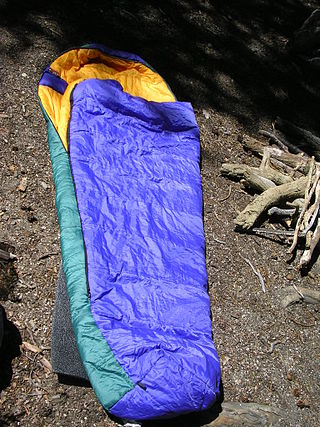
A sleeping bag is an insulated covering for a person, essentially a lightweight quilt that can be closed with a zipper or similar means to form a tube, which functions as lightweight, portable bedding in situations where a person is sleeping outdoors. It is also commonly used indoors for people who do not have beds or at sleepovers for when one or more persons cannot all fit in the bed or do not feel comfortable sleeping with someone. Its primary purpose is to provide warmth and thermal insulation through its synthetic or down insulation. It also typically has a water-resistant or water-repellent cover that protects, to some extent, against wind chill and light precipitation, but a tent is usually used in addition to a sleeping bag, as it performs those functions better. The bottom surface also provides some cushioning, but a sleeping pad or camp cot is usually used in addition for that purpose. The bottom surface of a sleeping bag may be moderately water repellent, but a plastic tarp or groundsheet is often used to protect against moist ground.

The Beauceron is a herding dog breed originating from the plains of Central France. The Beauceron is also known as Berger de Beauce or Bas Rouge (red-stockings).

Homeless shelters are a type of homeless service agency which provide temporary residence for homeless individuals and families. Shelters exist to provide residents with safety and protection from exposure to the weather while simultaneously reducing the environmental impact on the community. They are similar to, but distinguishable from, various types of emergency shelters, which are typically operated for specific circumstances and populations—fleeing natural disasters or abusive social circumstances. Extreme weather conditions create problems similar to disaster management scenarios, and are handled with warming centers, which typically operate for short durations during adverse weather.

A bivouac shelter or bivvy is any of a variety of improvised camp site, or shelter that is usually of a temporary nature, used especially by soldiers, or people engaged in backpacking, bikepacking, scouting, or mountain climbing. It may often refer to sleeping in the open with a bivouac sack, but it may also refer to a shelter constructed of natural materials like a structure of branches to form a frame, which is then covered with leaves, ferns, and similar material for waterproofing and duff for insulation. Modern bivouacs often involve the use of one- or two-man tents but may also be without tents or full cover. In modern mountaineering the nature of the bivouac shelter will depend on the level of preparedness, in particular whether existing camping and outdoor gear may be incorporated into the shelter.
The penny sit-up was one of the first homeless shelters, created for the people of Blackfriars, in central London, during the late nineteenth and early twentieth centuries. It was operated by the Salvation Army to provide comfort and support to its destitute clients. What made this shelter unique was that in exchange for a penny, clients would be allowed to sit on a bench in a reasonably warm room all night. They were not allowed to lie down and sleep on the bench. A penny sit-up was the cheapest homeless shelter at that time. There were more expensive shelters available in London, such as a "four penny coffin".
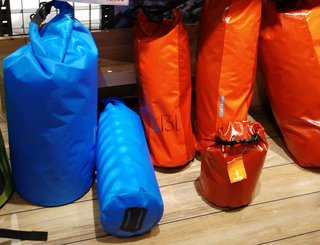
A dry bag is a type of flexible container which seals in a watertight manner. Dry bags are often used in kayaking, canoeing, rafting, canyoning, and other outdoor activities in which sensitive items would otherwise get wet, as well as extreme sports such as skiing and snowboarding. Dry bags are used to protect electronics from water. They are also used to prevent sleeping bags and spare clothing from getting wet, as in a camping context.

In England, local authorities have duties to homeless people under Part VII of the Housing Act 1996 as amended by the Homelessness Act 2002. There are five hurdles which a homeless person must overcome in order to qualify as statutory homeless. If an applicant only meets the first three of these tests Councils still have a duty to provide interim accommodation. However an applicant must satisfy all five for a Council to have to give an applicant "reasonable preference" on the social housing register. Even if a person passes these five tests councils have the ability to use the private rented sector to end their duty to a homeless person.

"Night of the Meek" is the first segment of the thirteenth episode from the first season (1985–86) from the television series The Twilight Zone. It is a remake of the original The Twilight Zone series episode, "The Night of the Meek", about a drunken department store Santa who finds a magical sack that can create presents and becomes a real-life Santa Claus. The title is almost unchanged from the original episode, even though the monologue from which the title was derived was replaced.
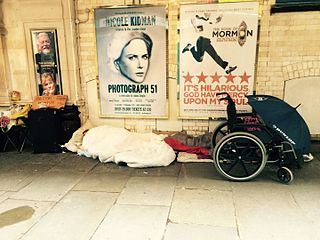
Homelessness in the United Kingdom is measured and responded to in differing ways in England, in Scotland, Wales and Northern Ireland but affects people living in all areas of the countries.

Homelessness or houselessness – also known as a state of being unhoused or unsheltered – is the condition of lacking stable, safe, and adequate housing. People can be categorized as homeless if they are:
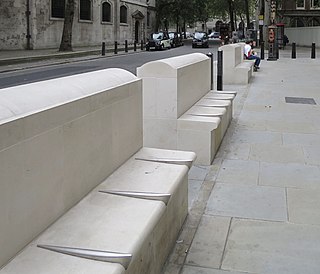
Discrimination against homeless people is the act of treating homeless people, or people perceived to be homeless, unfavorably. As with most types of discrimination, it can manifest in numerous forms.
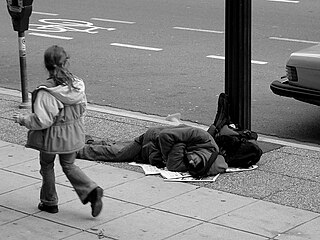
Anti-homelessness legislation can take two forms: legislation that aims to help and re-house homeless people; and legislation that is intended to send homeless people to homeless shelters compulsorily, or to criminalize homelessness and begging.
Homelessness is depicted in various popular culture works. The issue is frequently described as an invisible problem, despite its prevalence. Writers and other artists play a role in bringing the issue to public attention. Homelessness is the central theme of many works; in other works homelessness is secondary, added to advance the story or contribute to dramatic effect.
Clark v. Community for Creative Non-Violence, 468 U.S. 288 (1982), is a United States Supreme Court case with the National Park Service's regulation which specifically prohibited sleeping in Lafayette Park and the National Mall at issue. The Community for Creative Non-Violence (CCNV) group had planned to hold a demonstration on the National Mall and Lafayette Park where they would erect tent cities to raise awareness of the situation of the homeless. The group obtained the correct permits for a seven-day demonstration starting on the first day of winter. The Park Service however denied the request that participants be able to sleep in the tents. The CCNV challenged this regulation on the basis that it violated their First Amendment right.
The Homeless Bill of Rights refers to legislation protecting the civil and human rights of homeless people. These laws affirm that homeless people have equal rights to medical care, free speech, free movement, voting, opportunities for employment, and privacy. Legislation of this type is currently being debated at the state level in the United States. Over 120 organizations in five different states have shown public support for a Homeless Bill of Rights and are working towards its implementation. A Homeless Bill of Rights has become law in Rhode Island, Connecticut and Illinois and is under consideration by several other U.S. states, including California, Delaware, Minnesota, Missouri, Oregon, Tennessee, and Vermont.
The Empowerment Plan is an American humanitarian organization, located in Milwaukee Junction, Detroit, Michigan. The organization works to address homelessness by providing jobs to homeless women, and by manufacturing a coat that is given to homeless individuals in need.
Veronika Scott is an American social entrepreneur and CEO and founder of The Empowerment Plan, a Detroit-based humanitarian organization.
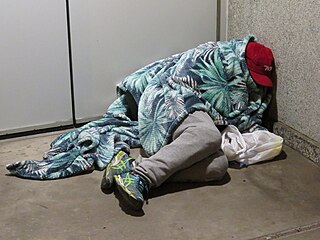
Homelessness is a growing problem in Colorado and is considered the most important social determinants of health. Homelessness is very difficult for many Coloradoans to escape due to the continuous increase in costs for housing in Colorado along with mental health treatments and other factors. When people are forced to live without stable shelter, they are then exposed to a number of risk factors that affect physical and mental health. Although it is difficult to pin point any one cause of homelessness, there is a complicated combination of societal and individual causes.
References
- ↑ "'This isn't the cure': Halifax woman starts conversation about homelessness with unique giveaway - Halifax | Globalnews.ca".
- ↑ "Coat as shelter: Designer Bas Timmer creates for people who have no home". Christian Science Monitor. 8 December 2020.
- ↑ "Sheltersuit coat doubles as a sleeping bag for the homeless". 9 November 2015.